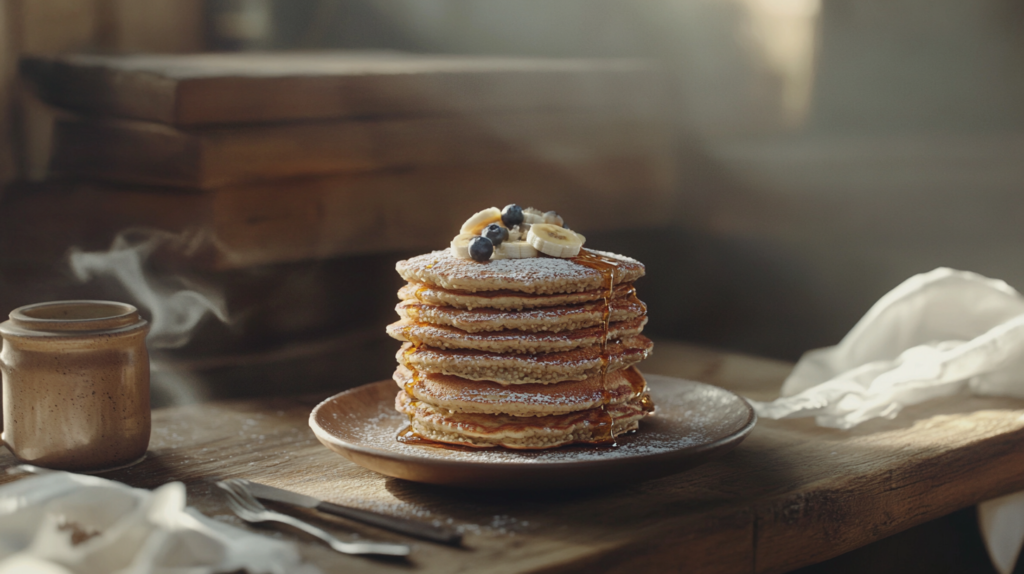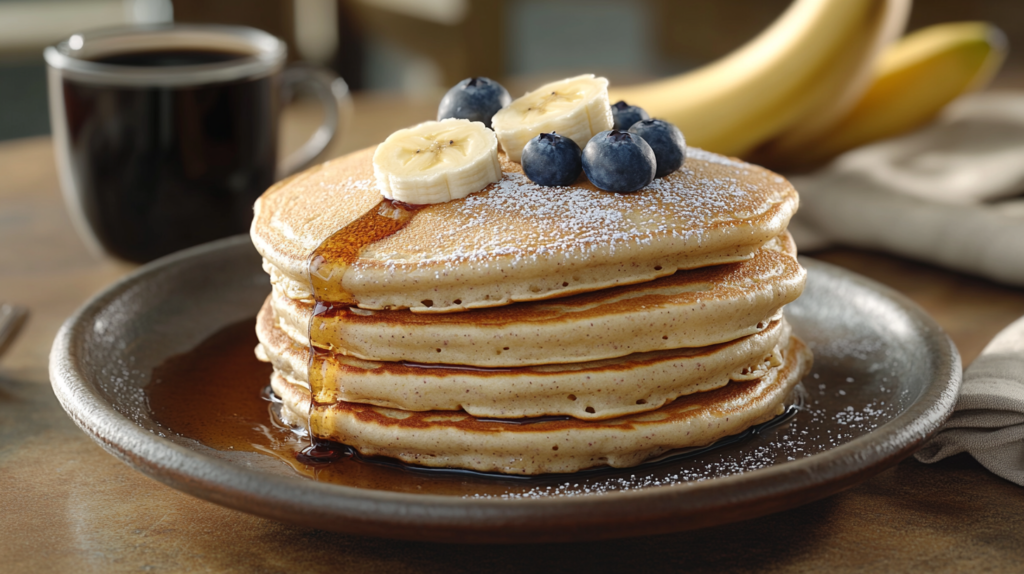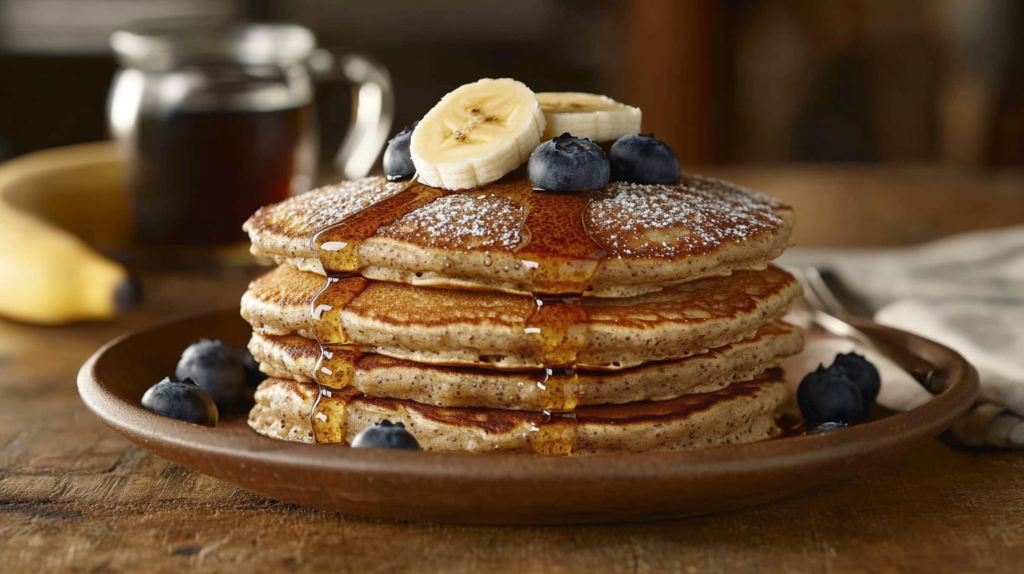Introduction to Buckwheat and Quinoa Flour Pancakes
recipes buckwheat and quinoa flour pancakes are a beloved breakfast staple, but using alternative flours like buckwheat and quinoa elevates their nutritional profile and makes them suitable for various dietary preferences.
Why Choose Buckwheat and Quinoa Flour for Pancakes?
Buckwheat and quinoa flour bring unique flavors and health benefits to pancakes. Buckwheat flour has a nutty, earthy taste and creates a hearty texture, while quinoa flour offers a mild, slightly sweet flavor with a soft crumb. These flours work well individually or together, providing a gluten-free base for light and fluffy pancakes.
Nutritional Benefits of Using Alternative Flours
- Buckwheat Flour: Rich in fiber, antioxidants, and essential minerals like magnesium and manganese. Despite its name, buckwheat is gluten-free and perfect for those with wheat sensitivities.
- Quinoa Flour: A high-protein flour containing all nine essential amino acids, making it a complete protein. It’s also rich in iron, calcium, and fiber, supporting overall health.
- Both flours contribute to more satiating, nutrient-dense pancakes compared to traditional wheat-based recipes.
Popularity of Gluten-Free and High-Protein recipes buckwheat and quinoa flour pancakes
As gluten-free and high-protein diets gain popularity, recipes using alternative flours like buckwheat and quinoa have become staples in health-conscious kitchens. These pancakes cater to diverse dietary needs, offering a nutritious and delicious option for breakfast enthusiasts.
Whether for dietary reasons or a desire for more wholesome ingredients, buckwheat and quinoa flour pancakes are a versatile and flavorful choice for modern breakfast tables.
Understanding Buckwheat and Quinoa Flours
Buckwheat and quinoa flours are nutritious and flavorful alternatives to traditional wheat flour, offering distinct characteristics that make them popular in gluten-free and health-focused recipes.
Buckwheat Flour: Origins, Flavor Profile, and Uses
- Origins: Despite its name, buckwheat is not related to wheat and is actually a seed. It has been a dietary staple in countries like Russia, Japan, and France for centuries.
- Flavor Profile: Buckwheat flour has a robust, earthy, and slightly nutty taste, adding depth to recipes.
- Uses: Commonly used in pancakes, crepes (like French galettes), noodles (soba), and baked goods. Its dense texture works well for hearty, rustic dishes.

Quinoa Flour: Nutritional Profile and Its Versatility
- Nutritional Profile: Quinoa flour is a powerhouse of nutrition. It contains all nine essential amino acids, making it a complete protein. It is also high in fiber, magnesium, and iron.
- Versatility: With its mild, slightly sweet flavor, quinoa flour is ideal for both sweet and savory recipes. It works well in pancakes, cookies, breads, and even pizza crusts.
How These Flours Complement Each Other
Buckwheat and quinoa flours complement each other beautifully in recipes:
- Flavor Balance: The robust, earthy flavor of buckwheat is mellowed by the mild sweetness of quinoa.
- Texture: Combining the two flours creates a balanced texture—buckwheat’s density pairs with quinoa’s soft crumb, resulting in light yet hearty pancakes.
- Nutritional Synergy: Together, these flours offer a blend of fiber, protein, and essential nutrients, making dishes more wholesome and satisfying.
By understanding the unique qualities of buckwheat and quinoa flours, you can harness their strengths to create nutritious, flavorful recipes that cater to diverse dietary needs and preferences.
Essential Ingredients for Buckwheat and Quinoa Flour Pancakes
Creating delicious and nutritious pancakes with buckwheat and quinoa flours starts with a mix of essential and customizable ingredients. These elements can be adjusted to suit various dietary preferences and flavor profiles.
Overview of Pantry Staples: Eggs, Milk, Sweeteners
- Eggs: Provide structure and help bind the batter, resulting in fluffy pancakes. For a vegan option, flaxseed or chia seed mixed with water can be used as a substitute.
- Milk: Adds moisture to the batter. Dairy milk works well, but plant-based options like almond, oat, or soy milk are excellent for dairy-free pancakes.
- Sweeteners: A touch of sweetness enhances flavor. Options include sugar, honey, maple syrup, or even natural sweeteners like stevia.
These staples form the foundation of the pancake batter, ensuring the right consistency and flavor balance.
Optional Add-ins: Fruits, Nuts, and Spices
- Fruits: Add fresh or dried fruits like blueberries, bananas, or chopped apples for bursts of sweetness and added nutrients.
- Nuts and Seeds: Chopped walnuts, pecans, or chia seeds contribute crunch and healthy fats.
- Spices: Cinnamon, nutmeg, or vanilla extract can enhance the pancakes’ flavor and aroma.
These add-ins allow for creative and flavorful variations, making each batch of pancakes unique.
Adjusting Ingredients for Dietary Needs (Vegan, Dairy-Free, etc.)
- Vegan Pancakes: Replace eggs with flax or chia seeds mixed with water, and use plant-based milk.
- Gluten-Free Pancakes: Ensure all ingredients, such as baking powder, are labeled gluten-free to avoid cross-contamination.
- Low-Sugar Options: Use unsweetened plant-based milk and natural sweeteners like monk fruit or a small amount of honey.
By adjusting the ingredients, you can cater these pancakes to specific dietary preferences while maintaining their delicious flavor and texture.
Combining pantry staples with optional add-ins allows you to customize buckwheat and quinoa flour pancakes to your liking. Whether you’re cooking for health, flavor, or dietary needs, these pancakes can be tailored to fit any breakfast table.
Tools Needed for Perfect Pancakes
Making perfect pancakes with buckwheat and quinoa flour requires the right tools and techniques. From mixing to cooking, having the proper equipment ensures consistent results and a hassle-free experience.
Must-Have Kitchen Equipment
- Mixing Bowls: Use one for dry ingredients and another for wet ingredients to ensure even mixing without lumps.
- Whisk or Hand Mixer: A whisk is ideal for blending ingredients smoothly. A hand mixer can save time for larger batches.
- Ladle or Batter Dispenser: Helps pour the pancake batter evenly onto the cooking surface.
- Spatula: A thin, flexible spatula makes flipping pancakes easy without breaking them.
Tips for Using Non-Stick Pans and Griddles
- Preheat Properly: Heat the pan or griddle on medium heat before adding batter to ensure even cooking and prevent sticking.
- Use Minimal Oil or Butter: Lightly grease the surface with oil, butter, or a non-stick spray to create a golden crust without burning.
- Control Heat: Keep the temperature consistent to avoid pancakes that are burnt on the outside but undercooked inside.
A non-stick pan or a cast-iron griddle with a smooth surface is ideal for achieving evenly cooked, golden-brown pancakes.
Measuring Tools for Consistent Results
- Measuring Cups and Spoons: Ensure precise measurements of flours, liquids, and other ingredients for a well-balanced batter.
- Kitchen Scale: For more accurate baking, especially when working with alternative flours like buckwheat and quinoa, a scale can be helpful.
- Timer: Use a timer to track cooking time, ensuring each pancake is cooked evenly on both sides.
Accurate measuring and consistent cooking techniques lead to perfectly fluffy and uniform pancakes every time.
With the right tools and attention to detail, making buckwheat and quinoa flour pancakes becomes a seamless and enjoyable process. These essentials not only simplify preparation but also guarantee beautiful, delicious pancakes.
Step-by-Step Recipe for Buckwheat and Quinoa Flour Pancakes
This step-by-step guide will help you create delicious and nutritious pancakes using buckwheat and quinoa flours. Whether you prefer fluffy or thin pancakes, adjustments and tips are included to ensure success.
Basic Recipe with Detailed Instructions
Ingredients:
- ½ cup buckwheat flour
- ½ cup quinoa flour
- 1 teaspoon baking powder
- 1 tablespoon sugar (optional)
- ¼ teaspoon salt
- 1 large egg (or flaxseed egg for vegan)
- ¾ cup milk (dairy or plant-based)
- 1 teaspoon vanilla extract
- 1 tablespoon melted butter or oil, plus extra for greasing
Instructions:
- Mix Dry Ingredients: In a large bowl, whisk together buckwheat flour, quinoa flour, baking powder, sugar (if using), and salt.
- Combine Wet Ingredients: In a separate bowl, beat the egg, then whisk in milk, vanilla extract, and melted butter or oil.
- Create the Batter: Gradually pour the wet ingredients into the dry ingredients. Mix until just combined. Do not overmix; small lumps are fine.
- Preheat the Pan: Heat a non-stick pan or griddle over medium heat and lightly grease with oil or butter.
- Cook the Pancakes: Pour ¼ cup of batter onto the pan. Cook until bubbles form on the surface and edges look set (about 2 minutes). Flip and cook the other side until golden brown (1–2 minutes).
- Serve and Enjoy: Stack the pancakes and serve warm with your favorite toppings like fresh fruits, syrup, or nuts.
Adjustments for Fluffy or Thin Pancakes
- Fluffy Pancakes: Add an extra teaspoon of baking powder and reduce the liquid slightly for thicker, fluffier pancakes.
- Thin Pancakes: Increase the milk by 2–3 tablespoons for a thinner batter, ideal for crepe-like pancakes.
Common Mistakes to Avoid
- Overmixing the Batter: Overmixing activates gluten (even in gluten-free flours), leading to dense pancakes. Mix until just combined.
- Cooking on High Heat: This can burn the outside while leaving the inside undercooked. Stick to medium heat for even cooking.
- Skipping the Rest Time: Letting the batter sit for 5–10 minutes allows the flours to hydrate, resulting in better texture.
- Not Greasing the Pan: Even with a non-stick pan, lightly greasing ensures the pancakes don’t stick.
By following this recipe and tips, you’ll create perfectly balanced buckwheat and quinoa flour pancakes, tailored to your preferred style and texture. Whether you’re cooking for a weekend brunch or meal prepping for the week, these pancakes are a nutritious and versatile choice.
Recipes for Buckwheat and Quinoa Flour Pancakes
Buckwheat and quinoa flour pancakes offer a delicious and nutritious alternative to traditional pancakes, perfect for gluten-free, high-protein, and health-conscious diets.
Introduction to Buckwheat and Quinoa Flours
Buckwheat flour provides a nutty, earthy flavor, while quinoa flour adds a subtle sweetness and protein boost. Combined, they create pancakes with a delightful balance of texture and taste. For other gluten-free breakfast ideas, explore pancake mix recipes for inspiration.
Step-by-Step Recipe
- Ingredients:
- ½ cup buckwheat flour
- ½ cup quinoa flour
- 1 tsp baking powder
- ¾ cup milk (dairy or plant-based)
- 1 egg or vegan substitute (e.g., flaxseed egg)
- 1 tbsp melted butter or oil
- Optional: cinnamon, vanilla extract, or sweeteners like honey
- Instructions:
- Mix dry ingredients in one bowl and wet ingredients in another.
- Combine both until just mixed—small lumps are okay.
- Cook on a preheated non-stick pan until bubbles form, flip, and cook the other side until golden.
For more tips on achieving the perfect pancake consistency, check out fluffy pancake techniques.

Optional Add-ins for Customization
Enhance your pancakes with:
- Fresh fruits: Blueberries or bananas.
- Nuts: Chopped walnuts or pecans.
- Spices: Cinnamon or nutmeg for added warmth.
Looking for other breakfast toppings? Pair with the ultimate yum-yum sauce for a unique twist.
Nutritional Benefits
These pancakes are rich in:
- Protein: Thanks to quinoa flour.
- Fiber: From buckwheat flour.
- Essential nutrients: Including magnesium and iron.
For more nutritious recipes, explore the Mediterranean quinoa power bowl, a perfect complement to your health-focused meal plans.
Final Thoughts
recipes buckwheat and quinoa flour pancakes are a versatile, healthful choice for any breakfast table. Experiment with flavors, and don’t forget to explore creative breakfast recipes for more ideas to start your day deliciously.
Conclusion
Recap of Benefits of Using Buckwheat and Quinoa Flours
Buckwheat and quinoa flours bring numerous benefits to your pancakes, including:
- Nutritional Value: High in protein, fiber, and essential nutrients like magnesium, iron, and amino acids.
- Dietary Inclusivity: Both flours are gluten-free, making them suitable for those with wheat sensitivities or celiac disease.
- Unique Flavors: Buckwheat offers a hearty, nutty taste, while quinoa adds a mild, slightly sweet note, creating a balanced and delicious pancake base.
These flours not only enhance the health profile of your pancakes but also add depth and character to the flavor.
Encouragement to Experiment and Personalize Recipes
Making recipes buckwheat and quinoa flour pancakes . Experiment with:
- Add-ins: Try fresh fruits, nuts, or spices for creative variations.
- Toppings: Pair with honey, maple syrup, or unique condiments like yum-yum sauce for an adventurous twist.
- Dietary Adjustments: Easily adapt the recipe to be vegan, dairy-free, or sugar-free by substituting ingredients.
By personalizing your pancakes, you can craft a dish that aligns perfectly with your tastes and dietary needs. Enjoy the process and discover how these flours transform your breakfast into a nutritious and flavorful delight.



